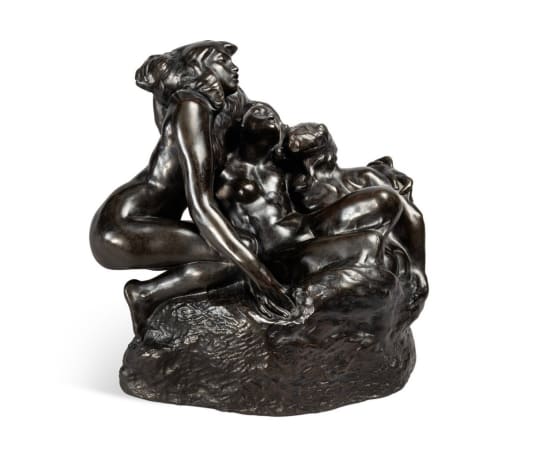Auguste Rodin (1840-1917) I 奧古斯特・羅丹 French
-
 Frère et soeur, Conceived circa 1890-1891, Cast in April 1903
Frère et soeur, Conceived circa 1890-1891, Cast in April 1903 -
 Amour qui passe, Conceived in 1885, Cast circa 1896-1901
Amour qui passe, Conceived in 1885, Cast circa 1896-1901 -
 Femme nue allongée, circa 1908-1914
Femme nue allongée, circa 1908-1914 -
 Petit Torse d'Iris dit aussi Petite Étude pour Iris, Messagère des Dieux avec Tête et Jambe Droite Levée, Conceived circa 1908-1909 I Cast in 1973
Petit Torse d'Iris dit aussi Petite Étude pour Iris, Messagère des Dieux avec Tête et Jambe Droite Levée, Conceived circa 1908-1909 I Cast in 1973 -
 Néréides, agrandissement dit aussi "Trois sirènes, grand modèle" ou "La Vague", Created in 1887, Cast in 1981
Néréides, agrandissement dit aussi "Trois sirènes, grand modèle" ou "La Vague", Created in 1887, Cast in 1981
奥古斯特·罗丹(Auguste Rodin,1840–1917)是一位法国雕塑家,被誉为现代雕塑的奠基人。他于1840年11月12日出生于巴黎,自幼展现出对艺术的天赋,并在14岁时进入小学院(Petite École),这是一所专门教授绘画和数学的学校。尽管他多次未能考入巴黎美术学院(École des Beaux-Arts),但他坚持不懈,最终成为一名装饰艺术家,不断磨练自己的雕塑和塑形技艺。
1864年,罗丹在巴黎沙龙展出了他的第一件重要雕塑——《断鼻男子》(L’Homme au nez cassé)。这件作品因其粗犷的现实主义风格和未完成的外观而遭到沙龙拒绝,但它已然标志着罗丹对传统雕塑规范的突破。1875年,他前往意大利旅行,深入研究米开朗基罗(Michelangelo)和多纳泰罗(Donatello)的作品,这一经历对他的艺术理念产生了深远影响。回到法国后,他创作了《青铜时代》(L’Âge d’Airain,1877年),因其极度逼真的造型,一度被指控是直接翻制真人模型。然而,这场争议不仅未能影响他的事业,反而使他名声大噪,进一步彰显了他精准捕捉人物情感和形态的非凡能力。
1880年,罗丹接到巴黎未来装饰艺术博物馆的大门雕塑委托,这一项目发展成为他最宏伟的作品——《地狱之门》(La Porte de l’Enfer),灵感来源于但丁的**《神曲》。尽管该博物馆最终未能落成,罗丹也未能在生前完成这部巨作,但其中的部分雕塑,如《思想者》(Le Penseur)和《吻》(Le Baiser),成为了世界上最著名的雕塑作品之一,充分展现了他在动态造型和情感表达**方面的卓越才能。
罗丹彻底革新了雕塑艺术,他强调现实主义、人物个性和情感表达,并常常刻意保留作品的“未完成”状态,以突出其原始美感。他为巴尔扎克(Honoré de Balzac)和维克多·雨果(Victor Hugo)等名人创作的雕像,进一步巩固了他作为雕塑大师的地位。尽管在其职业生涯中经历了诸多争议和批评,但罗丹始终忠于自己的艺术理念,他的作品挑战了传统美学观念,为未来的艺术家铺平了道路。
Bailly 画廊(Bailly Gallery)通过展出精选的雕塑、素描和版画,向罗丹的艺术遗产致敬。这些作品不仅帮助观众更深入地理解罗丹的创作过程,也展现了他对现代艺术的深远影响。通过展览和学术研究,Bailly 画廊为艺术爱好者和收藏家提供了一个独特的机会,让他们可以探索罗丹的艺术世界,感受他作品中微妙的艺术语言和创新精神。









